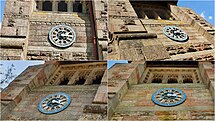
Cheddar is a large village and civil parish in the English county of Somerset. It is situated on the southern edge of the Mendip Hills, 9 miles (14 km) north-west of Wells, 11 miles (18 km) south-east of Weston-super-Mare and 18 miles (29 km) south-west of Bristol. The civil parish includes the hamlets of Nyland and Bradley Cross. The parish had a population of 5,755 in 2011 and an acreage of 8,592 acres (3,477 ha) as of 1961.

Cheddar Gorge is a limestone gorge in the Mendip Hills, near the village of Cheddar, Somerset, England. The gorge is the site of the Cheddar show caves, where Britain's oldest complete human skeleton, Cheddar Man, estimated to be 9,000 years old, was found in 1903. Older remains from the Upper Late Palaeolithic era have been found. The caves, produced by the activity of an underground river, contain stalactites and stalagmites. The gorge is part of a Site of Special Scientific Interest called Cheddar Complex.

The Mendip Hills is a range of limestone hills to the south of Bristol and Bath in Somerset, England. Running from Weston-super-Mare and the Bristol Channel in the west to the Frome valley in the east, the hills overlook the Somerset Levels to the south and the Chew Valley and other tributaries of the Avon to the north. The highest point, at 325 metres above sea level, is Beacon Batch which is the summit area atop Black Down. The hills gave their name to the former local government district of Mendip, which administered most of the local area until April 2023. The higher, western part of the hills, covering 198 km2 (76 sq mi) has been designated an Area of Outstanding Natural Beauty (AONB), which gives it a level of protection comparable to a national park.

Axbridge is a town in Somerset, England, on the River Axe, near the southern edge of the Mendip Hills. Its population according to the 2011 census was 2,057.
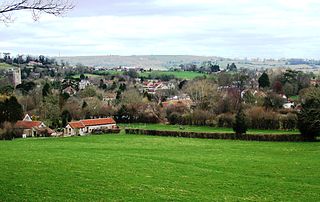
Chew Stoke is a small village and civil parish in the affluent Chew Valley, in Somerset, England, about 8 miles (13 km) south of Bristol and 10 miles north of Wells. It is at the northern edge of the Mendip Hills, a region designated by the United Kingdom as an Area of Outstanding Natural Beauty, and is within the Bristol and Bath green belt. The parish includes the hamlet of Breach Hill, which is approximately 2 miles (3.2 km) southwest of Chew Stoke itself.

Winscombe is a large village in the North Somerset unitary district of Somerset, South West England, close to the settlements of Axbridge and Cheddar, on the western edge of the Mendip Hills, 7 miles (11 km) southeast of Weston-super-Mare and 14 miles (23 km) southwest of Bristol. The Parish of Winscombe and Sandford, centred on the Parish Church of Church of St James the Great, includes the villages/hamlets of Barton, Hale, Oakridge, Nye, Sidcot and Woodborough.

Blagdon is a village and civil parish in the ceremonial county of Somerset, within the unitary authority of North Somerset, in England. It is located in the Mendip Hills, a recognised Area of Outstanding Natural Beauty. According to the 2021 census it has a population of 1,184. The village is about 12 miles (19 km) east of Weston-super-Mare and 12 miles south west of Bristol, on the A368 road to Bath.

Churchill is a village and civil parish in the unitary authority of North Somerset, part of the ceremonial county of Somerset. It is located on the western edge of the Mendip Hills, about 8 miles (12.9 km) east of Weston-super-Mare, and about 15 miles (24.1 km) south-west of Bristol. The parish, which includes the village of Lower Langford and the hamlet of Upper Langford, has a population of 2,250.

Crook Peak to Shute Shelve Hill is a 332.2 hectare (820.9 acre) geological and biological Site of Special Scientific Interest near the western end of the Mendip Hills, Somerset. The line of hills runs for approximately 5 kilometres (3.1 mi) from west to east and includes: Crook Peak, Compton Hill, Wavering Down, Cross Plain and Shute Shelve Hill. Most of the site is owned by the National Trust, which bought 725 acres (293 ha) in 1985, and much of it has been designated as common land. It was notified as an SSSI by Natural England in 1952.
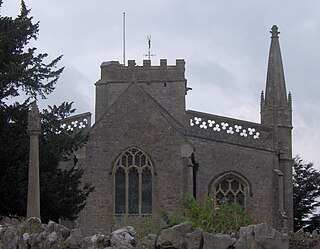
Burrington is a small village and civil parish in Somerset, England. It is situated in the unitary authority of North Somerset, just off the A368 between Blagdon and Churchill. 5 miles (8.0 km) north east of Axbridge and about 10 miles (16 km) east of Weston-super-Mare. The parish includes the hamlets of Bourne and Rickford and has a population of 464.
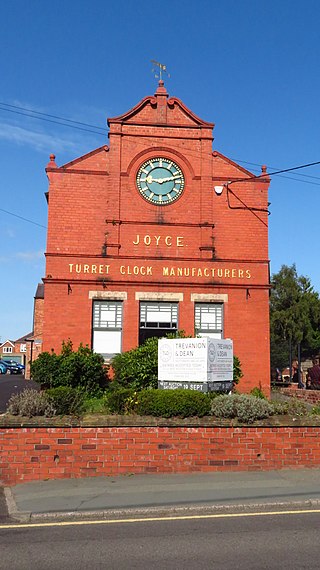
J. B. Joyce & Co, clockmakers, were founded in Shropshire in England. The company claim to be the oldest clock manufacturer in the world, originally established in 1690, and have been part of the Smith of Derby Group since 1965. The claim is challenged by another English firm of clockmakers, Thwaites & Reed, who claim to have been in continuous manufacture since before 1740, with antecedents to 1610.
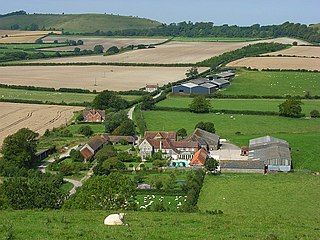
Maiden Bradley is a village in south-west Wiltshire, England, about 6 miles (10 km) south-west of Warminster and bordering the county of Somerset. The B3092 road between Frome and Mere forms the village street. Bradley House, the seat of the Duke of Somerset, is adjacent to the village.

Lower Langford is a village within the civil parishes of Churchill and Burrington in the unitary authority of North Somerset, England. It is located on the western edge of the Mendip Hills about 8 miles east of Weston-super-Mare. It was a village built around the estate of Sidney Hill who was the original inhabitant of the village. The estate is now the Bristol Veterinary School of the University of Bristol.
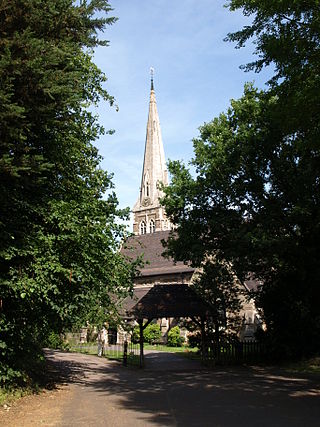
St. Mary's Church, Selly Oak is a Church of England parish church in Selly Oak, Birmingham, England.

The Church of St Mary in Bruton, Somerset, England was largely built in the 14th century. Like many Somerset churches, it has a very fine tower; less usually it has a second one as well. Simon Jenkins has called Bruton's tower "Somerset architecture at its most powerful." It has been designated a Grade I listed building.
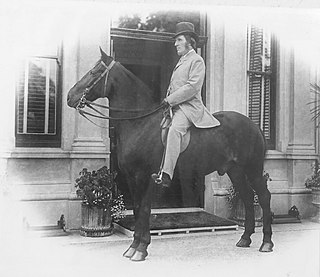
Simon Sidney Hill was an English philanthropist, merchant, gentleman farmer, and justice of the peace. From beginnings as a linen merchant, he made his fortune as a colonial and general merchant trading from South Africa. He supported and endowed almshouses in Churchill and Lower Langford, and manses for Methodist clergy at Banwell and Cheddar. He founded Methodist churches at Port Elizabeth, Sandford, Shipham and Blagdon besides the Wesley Methodist church and school at Churchill. Many of his charitable foundations still survive.
John Foster, was an English architect and partner in the architectural practice of Foster & Wood of Park Street, Bristol who designed a number of well known buildings erected in Bristol in the 19th century. "It must sometimes seem that the whole of 19th-century Bristol, or at least all of its significant buildings, owed their design to the firm of Foster and Wood".

Sidney Hill Cottage Homes, whose official name is Sidney Hill Churchill Wesleyan Cottage Homes, is a Grade II listed estate of Wesleyan cottage homes in the village of Churchill in North Somerset. It was opened in December 1907 to provide furnished accommodation for people in need. Designed in an Arts and Crafts Vernacular style by Thomas Ball Silcock and Samuel Sebastian Reay of Silcock and Reay, architects at Bath and London, twelve cottages were constructed on three sides of a quadrangle, with landscaped gardens. The third, or south side, is enclosed by a low terrace wall with wrought iron gates. A large stone sundial, with a spreading base, is set in the centre of the quadrangle. In their original form, each house had a living room, with a small scullery, larder, coal house, and one bedroom with a large storeroom.

Churchill Methodist Church, in the village of Churchill, North Somerset, is a Grade II listed Methodist church on the Somerset Mendip Methodist Circuit. Designed by Foster & Wood, Bristol, of Perpendicular Gothic style, the church opened on 2 May 1881. The schoolroom and coach house, of Elizabethan architecture, were erected before the new church, and opened on 1 June 1879 (Whitsun). Sidney Hill, a wealthy local businessman and benefactor, erected the church and schoolroom as a memorial to his wife.








